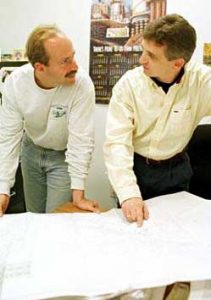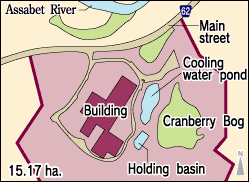Discounted Casualties:The Human Cost of Depleted Uranium, Part 2 <2>Removal of contamination – High costs – dim prospects
Apr. 25, 2000
External contamination feared
"The Starmet site is heavily contaminated." Stephen Roberson (41), environmental analyist, and his colleague Christopher Pyatt (39), site manager, both employed by the state of Massachusetts, looked at each other over a map of the company grounds. "The only question is, where do we get the money to clean it up?"
I met Roberson and Pyatt in Wilmington, Massachusetts, at the Northwest Branch of the Massachusetts Department of Environmental Protection. The two are charged with handling the problem of radioactive contamination at Starmet Corporation (formerly, Nuclear Metals Inc.) located in Concord.
An estimated $10 million
"The removal of sludge containing DU and other contaminants in the holding basin from 1997 to 1998 was a start. However, it will take more money to remove sludge from Cranberry Bog and contaminated groundwater and soil from under the former holding basin," Roberson said reflectively.
Roughly $10 million is the estimate of the Department of Environmental Protection. Depending on how far underground the contamination has spread, the cost could be up to five times higher.
As the pollutor, Starmet should pay for the clean-up, but a drop in military contracts in recent years has drastically reduced business. Its staff is under 100, less than a sixth of its peak numbers. Neither is the state government able to fund the project. The company can either rely on the army, as it did for the first clean-up, or be designated one of the country's worst contamination sites and become eligible for the Environmental Protection Agency's Superfund.
However, though Massachusetts congressmen and senators approached the military about the matter, "The military's pretty tight with its money," says Roberson.
The situation is complicated by the resistance of some Concord residents to having a local property designated a Superfund site. "They're proud of Concord's history and culture, and they want to protect its image as an affluent residential area. Superfund designation would ruin its image and decrease property values."
Roberson and Pyatt have explained the state's position at town meetings and other local gatherings. While basically respecting the choice of the residents, the state's stance is, "If the clean-up goes ahead, no one will care where the money comes from."
"Nothing is more dangerous than leaving toxic pollutants in the environment. If they leak outside the company' property, we can't let the town's image stand in the way of a clean-up," adds Pyatt.
Toothless national regulations
How did Startmet contaminate the environment to this extent?
"Because it handles nuclear materials, its business license was controlled by the Nuclear Regulatory Commission (NRC), which also regulated and monitored its daily activities. However, there were no substantial regulations until 1985. Starmet was basically on its own."
Roberson's explanation reminded me of the criticality accident in September 1999 at JCO's nuclear fuel processing facility in Tokai Mura, Ibaraki Prefecture. The failure of Japan's Science and Technology Agency to apprehend that facility's neglect of proper procedures was similar to the NRC's indulgence of Starmet.
The Department of Environmental Protection first began to investigate Starmet in 1985. The initial investigation was not of radioactivity contamination from DU but of chemical contamination of well water on the premises. No full-scale radioactive contamination study was performed until 1991.
Leaching groundwater
In one test, DU in the groundwater around the former holding basin measured 87,000 micrograms per liter, roughly 3,100 times the state limit for tap water (28 micrograms per liter). Soil DU concentration averages about 460 milligrams per kilogram, or 23 times the state's post-clean-up standard of 20 milligrams per kilogram. Contaminated groundwater is already leaching from the holding basin and moving rapidly toward the property's edge near the Assabet River.
"It was seven or eight years from the time the demand was first made until the sludge-and only the sludge-was removed. We can't let it take that long this time." As they spoke, alarm tensed the faces of Roberson and Pyatt.
(Originally published on April 25, 2000)









